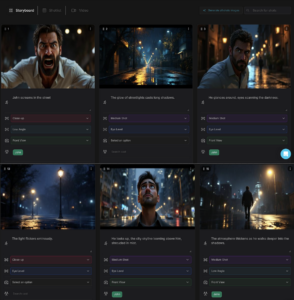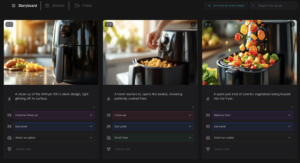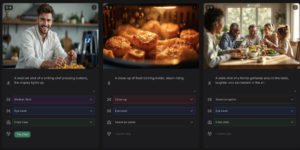Advertising AI Storyboard Generator: A New Era of Campaign Visualization
Discover how an advertising AI storyboard generator transforms campaign planning—enhancing speed, accuracy, and creative alignment for modern marketers and ad agencies.
In the fast-paced world of advertising, ideas move quickly—but execution needs to be just as agile. One of the most overlooked tools for campaign success is the storyboard. A good storyboard doesn’t just visualize a script—it aligns teams, clarifies vision, and reduces costly errors. And now, with the rise of the advertising AI storyboard generator, this once time-consuming step has become faster, smarter, and more scalable.
Whether you’re producing a punchy Instagram ad, a YouTube bumper, or a high-production TV spot, storyboarding with AI helps you map it out clearly—without waiting on an illustrator or designer. For brands, agencies, and creators alike, this shift is opening up a new level of creative agility.
Why Storyboards Still Matter in Advertising
Advertising is about telling compelling stories in short bursts—sometimes in six seconds, sometimes in thirty. You rarely have time to explain everything, so every frame must do the work of ten. That’s where a storyboard becomes essential: it allows you to explore the flow of visuals, test your message, and ensure everything feels cohesive before you enter production.
It also keeps teams aligned. Copywriters, art directors, motion designers, and clients can all get a clear, shared understanding of what’s being created. Miscommunication is reduced. Revisions are smarter. And final outputs feel more intentional.
From Manual Sketching to AI-Driven Storyboarding
Traditionally, storyboarding involved hiring illustrators or leaning on internal designers to sketch frame-by-frame ideas. While effective, it’s not a scalable process—especially for brands testing multiple versions of ads or iterating across formats like vertical, square, or 16:9.
With an AI storyboard generator, this changes. Instead of drawing by hand, you input a script, description, or concept—and AI returns visual panels almost instantly. This automation frees up time and resources, especially in fast-moving environments.
Tools like Shai are designed specifically for this type of work. You paste in your scene ideas or script, choose a visual tone, and within seconds you receive a full storyboard draft. But it’s not just about speed—it’s about control. Shai lets you define brand elements, generate characters using its AI character generator, and ensure visual coherence through AI character consistency, so each frame feels on-brand.
Manual Storyboard sketching 
vs AI Storyboard generators like Shai. Images can be generated as black and white sketches as well as animation, photorealistic style, and so much more. 
How Shai Enhances the Advertising Workflow
Where Shai shines is in its ability to handle campaign-specific customization. You can upload product visuals, logos, and set brand colors to match your guidelines. You can even tailor characters to reflect recurring figures—like a brand ambassador or mascot—and trust that the AI will keep them consistent across scenes.
Edits are fast and intuitive. Want to change the background of scene 3? Click and update it. Need to try a more energetic tone? Reframe the prompt and regenerate that panel. The interface is designed for iteration, not perfection on the first try—and that’s exactly how modern advertising works.
When you’re done, exporting is simple. Shai allows you to download your storyboard as a PDF, video slideshow, or web link—ready to share with your creative team, client, or production partner.
Why Shai is the Best Fantasy AI Storyboard Generator
-
⚡ Faster Turnarounds – Full storyboard in minutes
-
🧠 Smart Visualization – AI interprets tone, mood, and setting
-
🔁 Easy Revisions – Update script → regenerate visuals
-
🤝 Team Collaboration – Cloud workspaces, comments, and version control
Real-Life Campaigns Using AI Storyboarding
More and more brands are building storyboards with AI as part of their daily workflow. A wellness brand recently used Shai to plan an entire video series for social media. By the end of day one, they had three storyboard variations and a clear direction—cutting what used to be a week-long process down to a matter of hours.
In another case, a mid-size agency preparing a pitch created two completely different visual narratives using Shai in under 48 hours. Having both options laid out visually gave their client clarity and confidence—and won the project.
Retail and e-commerce brands, especially those juggling fast seasonal cycles, are using AI storyboards to pre-visualize ads for different platforms before committing to filming. This reduces guesswork and helps teams make more informed creative decisions upfront.
Where AI Excels—and Where Human Creativity Still Matters
While AI has come a long way, it’s not a creative director. It won’t invent your story, define your tone, or understand subtle emotional beats unless you guide it. That’s why it’s best viewed as a creative assistant, not a replacement.
The biggest risk with any AI workflow is over-reliance. The tech can generate great-looking images, but without a strong idea behind them, they won’t resonate. Fortunately, platforms like Shai are built with that balance in mind—they give you speed and flexibility, but you still call the shots.
You also need to be aware that visuals may not always hit the mark perfectly. In cases where product realism or celebrity likeness is critical, you may still want to involve a designer or art director to refine things.
The Future of Advertising AI Storyboards
Looking ahead, AI won’t just help generate storyboards—it will help optimize them. Imagine uploading a storyboard and getting predictive feedback: “Frame 2 might lose engagement on mobile,” or “Try shifting your CTA one frame earlier.”
Soon, AI tools like Shai may integrate performance data from past campaigns to help creatives build ads that not only look good but perform better from the start.
There’s also growing potential in personalized storyboarding—using data to generate different story versions for different audiences. The same campaign could have a youth-focused version, a premium shopper version, and a general audience version, all storyboarded automatically in parallel.
See below an example of advertising AI storyboard we made for Philips Airfryer.


Final Thoughts
The tools we use shape the stories we tell—and how quickly we can tell them. In a world where advertising demands speed, flexibility, and visual clarity, the advertising AI storyboard generator is becoming a critical part of the creative toolkit.
Platforms like Shai don’t just make storyboard creation easier—they make it possible for more teams, with fewer resources, to move faster and make better creative decisions. For agencies and brands that want to keep up with the pace of digital storytelling, it’s not just a nice-to-have—it’s a competitive edge.
By using AI to visualize your ideas, iterate quickly, and collaborate more effectively, you can spend less time sketching—and more time shaping stories that sell.
Visit shaicreative.ai and start building your world today.